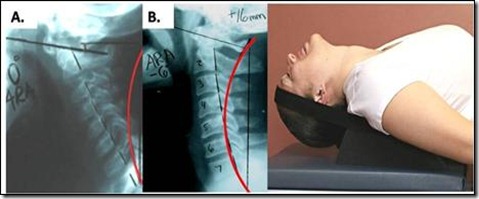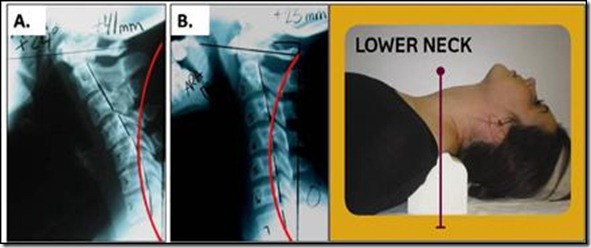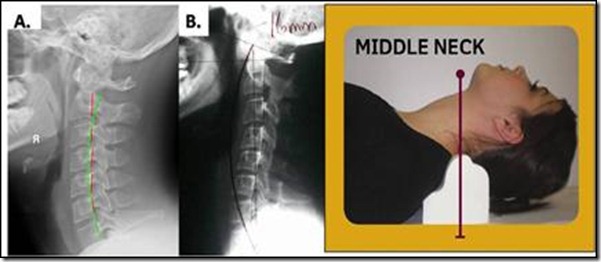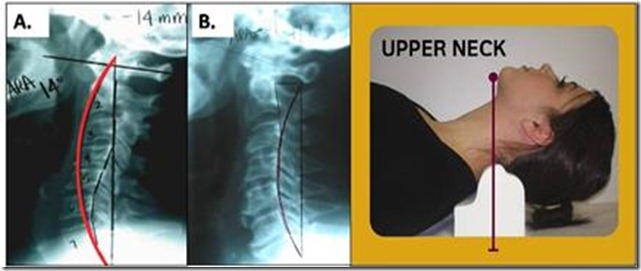BioPhysics Insights: Determining the Appropriate Home Traction for Abnormalities of the Cervical Lordosis
 Tuesday, September 14, 2010 at 6:49AM
Tuesday, September 14, 2010 at 6:49AM Deed E. Harrison, DC
President CBP Seminars, Inc.
Vice President CBP Non-Profit, Inc.
Chair PCCRP Guidelines
Editor—AJCC
INTRODUCTION
Recently in this journal, I’ve been discussing the evidence for the use of home corrective orthotic (cervical curve traction) devices as a supplementation to in office CBP treatment programs aimed at rehabilitation of abnormal cervical curvatures. In this article I will continue the discussion of home corrective orthotic devices by presenting appropriate indications and contra-indications for the use of these devices. Just like the CBP in office traction rehabilitation equipment (Compression-extension chair,1 Pope 2-way,2 Compression-extension 2-way,3 etc.), there is no such thing as a “one size fits all” for at home orthotics. Specifically, I will discuss two primary types of cervical corrective orthotic devices for at home use: 1) The TruCurve compression-extension orthotic, and 2) The Denneroll cervical orthotic device.
Figure 1. The TruCurv Compression extension spinal corrective orthotic device for at home use. The patient lies over a wedge shaped fulcrum with the upper thoracic region (T4) at the apex of the wedge. The compression force is applied to the forehead by way of a strap; straightening the legs increases the compression-extension loading.
Compression Extension Corrective Loading
The Compression-extension at home cervical orthotic device has been around a number of years and is modeled after the in office device Compression-extension traction chair (‘Regainer’) designed by Dr. Dwight DeGeorge of Promote Chiropractic in the late 1980’s. In corrective chiropractic practices around the world, this is the most commonly recommended home device for restoration of the cervical lordosis. In Figure 1, the TruCurv compression extension orthotic device is shown; this is device that CBP recommends and distributes to doctors. Although the compression-extension orthotic is a very effective device, in my opinion it is one of the most miss-used cervical orthotics on the market. Allow me to explain my position by discussing the Contra-indications and Indications of this orthotic.
There are a number of patient conditions and spinal configurations compression-extension loading would likely exacerbate; these conditions would be considered Contra-indications to compression-extension loading. Like-wise, there should be a unique set of patient conditions and spinal configurations that compression-extension loading would likely improve.
Contra-indications to compression-extension loading:
· A significant retrolisthesis in the cervical spine; especially one that is unstable on extension loading. Under combined loads of compression-extension the segments of the cervical spine are subjected to posterior shear loads.4
· A normal thoracic kyphosis without posterior translation of the thoracic cage relative to the pelvis. Due to the fact that the patient is lying on a wedge in the mid-thoracic spine, the ribcage will be translated anteriorly. It is a known biomechanical fact that anterior thoracic translation causes straightening of the thoracic kyphosis.5Furthermore, the compression extension force acting on the skull creates an extension bending moment at the upper thoracic region where it contacts the apex of the traction wedge. This scenario causes a flattening of the upper thoracic curve--take an X-ray of a patient to confirm this if you doubt it!
· Hyper-extension of the upper cervical spine. See Figure 2A. A combined compression-extension force would create even more hyper-extension in the upper cervical region.
· Significant anterior head translation where the lower cervical spine flexes (C4-T1) and the upper cervical spine extends (C0-C4). See Figure 2B. In this case, the cervical spine is behaving as it should for an anterior head posture.6 In other words, the forward head posture is the cause of the alteration in the cervical curvature. Compression-extension loading of the head/neck region is an inappropriate force to correct forward head posture.
· Canal stenosis or canal diameter less then or equal to 11 mm is a contra-indication for compression-extension loading. While this can be a case specific contra-indication, many patients with canal stenosis will experience exacerbation of symptoms (radicular or long-tract signs) with an applied compression-extension load. It is simply better pursue a different type of corrective force.
Figure 2. Cervical Curve Contraindications to Compression Extension forces. In A, there is excessive upper cervical extension and a retro-listhesis at C3-C4. While B, is the typical spinal coupling pattern for an anterior head translation posture. Compression Extension force application would likely cause injury to the upper-cervical region in these cases.
Indications for compression-extension loading:
- Antero-listhesis with loss of lordosis and anterior head translation.
- No absolute canal stenosis or canal diameter ≥ 11 mm.
- No hyper-extension of the upper neck.
- Significant Anterior translation of the head with the following three features:
a) Hypo-lordosis of the cervical spine and,
b) Posterior thoracic translation and,
c) Mild-to moderate hyper thoracic kyphosis in the upper thoracic region (T1-T4).
- In general, compression-extension loading to restore the cervical lordosis is used when a patient has anterior head translation and posterior thoracic translation with a loss of the cervical lordosis where the majority of the posterior vertebral body margins are in front of the ideal spinal model (shown as a red-circular segment in most of the figures). See Figure 3.
Figure 3. Abnormal cervical curvatures that are INDICATED for the TruCurv Extension Compression corrective force application. These curves are hypo-lordotic with significant forward displacement of the head and the posterior body margins relative to the CBP ideal cervical model.1 Note that the patient must also have:
- Posterior thoracic translation and;
- A mild-to moderate increase of the mid-upper thoracic kyphosis.
The Denneroll cervical orthotic device (Figure 4-6) overcomes the specific case contra-indications that are inappropriate for the compression extension home device. The Denneroll is a passive 3-point bending force that is generally well tolerated by patient and is most consistent with the Pope-2-way type of in office corrective traction force. The Denneroll currently comes in 2 sizes (adult large and adult small) and can be used when the TruCurv compression-extension device is contraindicated. There are three primary placements of the Denneroll cervical orthotic device shown in Figures 4-6. The Denneroll placement should be consistent with both the shape of the cervical curve and the amount/type of sagittal head translation correction that is desired.
Indications for the Denneroll:
· Upper thoracic/lower cervical placement. This placement of the Denneroll will cause significant posterior head translation, it will increase the upper thoracic curve, and increase the overall cervical lordosis. Specifically, this placement should be used for straightened or kyphotic lower cervical segments with loss of upper thoracic kyphosis and anterior head translation of ≤ 40mm. See Figure 4.
Figure 4. Abnormal cervical curvatures that fit the inclusion criteria for the application of the Denneroll corrective orthotic in the lower cervical region. These spines must have:
· Normal or a mild loss of the upper thoracic kyphosis;
· Loss of the lower cervical curve (with or without kyphosis);
· Anterior head translation of approximately ≤ 40mm.
· Mid-low cervical placement. This placement of the Denneroll will cause slight posterior head translation; however if the larger Denneroll device is used on a small statured individual then it will create some anterior head translation. The cervical spine should have straightened or kyphotic mid cervical regions (apex of the curve). See Figure 5. In cases with significant posterior head translation, as in Figure 5A, the large Denneroll orthotic should be used and a towel can be placed under the Denneroll to increase the height if needed.
Figure 5. Abnormal cervical curvatures that fit the inclusion criteria for the application of the Denneroll corrective orthotic in the middle cervical region. These spines must have:
· Normal or a loss of the upper thoracic kyphosis;
· Straightening or apex at the mid-cervical curve;
· Slight anterior head translation of approximately ≤ 15mm;
· In B with Posterior head translation the LARGE Denneroll should be used with a small towel under it to increase height.
· Upper to mid cervical placement. This placement of the Denneroll is used for posterior head translation with straightened or kyphotic mid-upper cervical curves. This position allows extension bending of the upper cervical segments while causing slight anterior head translation. See Figure 6. In cases like Figure 6A with significant posterior head translation, where the posterior vertebral bodies are behind the ideal red curved line,7 the large Denneroll orthotic should be used. While in Figure 6B, the small Denneroll should be used.
Figure 6. Abnormal cervical curvatures that fit the inclusion criteria for the application of the Denneroll corrective orthotic in the upper cervical region. These spines must have:
· Close to normal lower cervical curvature;
· Straightening or apex at the C2-C4-cervical segments;
· In B, normal head translation of approximately ≤ 15mm. Here the SMALL Denneroll is used to not create anterior head posture;
· In A with Posterior head translation the LARGE Denneroll should be used to create anterior head translation.
Contra-indications for the Denneroll:
Quite simply put, the Contra-Indications for the Denneroll orthotic device would be the same indications for the TruCurve compression-extension orthotic.
SUMMARY
All home cervical corrective orthotic devices have indications and contra-indications. Simply put, the two devices discussed herein (TruCurve and Denneroll) should be used in opposite patient cases. The cervical corrective orthotic should be fit to the following patient presenting conditions: 1) their symptomatology and severity of spinal arthritis/disc disease, 2) their ability to perform specific movements, 3) their presenting posture of the head and thoracic region, 4) their configuration of the cervical curvature, and 5) their configuration of the mid-upper thoracic kyphosis. I hope this presentation assists in your delivery of effective patient intervention in the office and at supplementation of at home devices.
References
- Harrison DD, et al. J Manipulative Physiol Ther 1994;17(7):454-464.
- Harrison DE, et al. Arch Phys Med Rehab 2002; 83(4): 447-453.
- Harrison DE, et al. J Manipulative Physiol Ther 2003; 26(3): 139-151.
- Harrison DE, Harrison DD, et al. J Manipulative Physiol Ther 1998; 21(3): 177-86.
- Harrison DE, Cailliet R, Harrison DD, Janik TJ. Eur Spine J 2002; 11(3): 287-293.
- Harrison DE, Harrison DD, Haas JW. CBP Structural Rehabilitation of the Cervical Spine. Chapters 2 & 6. CBP Seminars, 2002; pgs:147-151. ISBN 0-9721314-0-X.
- Harrison DD, et al. Spine 2004; 29:2485-2492.
 CBP Seminars | Comments Off |
CBP Seminars | Comments Off | 









